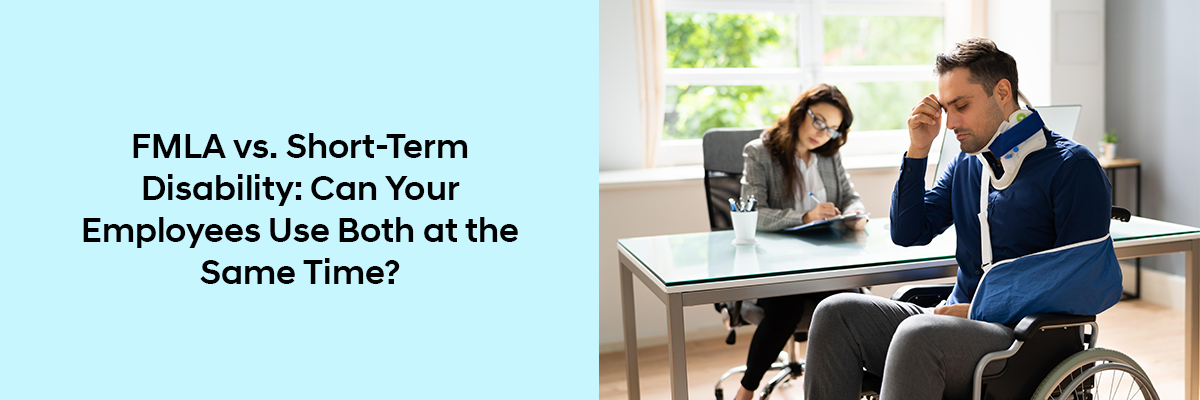Employees need time off for all sorts of reasons: health issues, surgeries, pregnancies, family emergencies, and sometimes just a break to take care of their mental health. And when life gets serious, medical leave isn’t optional, it’s essential. Without it, employees burn out, productivity tanks, and companies see more turnover.
The good news? There are leave options out there. But knowing which one applies, and when, is where things get tricky.
Among the most important types of leave tied to medical conditions are FMLA (Family and Medical Leave Act) and Short-Term Disability (STD). Both are commonly used, but they serve very different functions. One protects the employee’s job, the other helps cover their income. The real question is: can they be used at the same time? Short answer, yes, usually. But there’s more to it. Let’s break it all down.



What Is FMLA Leave (Family and Medical Leave Act)?
FMLA is a federal law that allows eligible employees to take up to 12 weeks (60 workdays) of unpaid, job-protected leave in a 12-month period for qualifying family or medical reasons.
FMLA at a Glance:
Who qualifies? Employees who:
- Have worked for the employer for at least 12 months
- Have logged 1,250 work hours in the past year
- Work at a location with at least 50 employees within 75 miles
How long is the leave?
- 12 workweeks (i.e., 60 workdays) per year
- 26 weeks (130 workdays) if caring for a covered military service member with a serious injury (Military Caregiver Leave)
Is it paid?
No, unless the employer offers paid leave or the employee uses accrued paid time (like PTO or sick days)
Reasons an employee might use FMLA:
- Serious health condition (surgery, illness, injury, chronic condition)
- Maternity or paternity leave (bonding with a new child)
- Caring for a family member with a serious condition
- Military-related absences (deployment or caregiving)
Does it protect the job?
Yes. The employee is entitled to return to the same (or an equivalent) position after their leave ends.
To know more about Difference Between FMLA and Intermittent FMLA, do give our in- depth blog a read.
What Is Short-Term Disability (STD)?
Short-Term Disability isn’t a federal law, it’s a private insurance benefit. It provides employees with partial wage replacement when they’re temporarily unable to work due to a qualifying non-work-related medical condition.
STD at a Glance:
Who qualifies?
Depends on the employer’s plan. Most policies require the employee to be enrolled, sometimes for a certain amount of time before becoming eligible.
How long does it last?
Most STD plans cover up to 12 to 26 weeks (3 to 6 months), depending on the policy.
How much does it pay?
Usually 50% to 70% of the employee’s regular wages, capped at a weekly maximum.
What types of conditions are covered?
- Serious illnesses (like pneumonia, cancer, or severe depression)
- Surgery recovery
- Pregnancy and childbirth recovery (typically 6–8 weeks post-delivery)
- Injuries not related to work (e.g., broken bones, back issues)
Does it protect the job?
No. STD helps replace income, but it doesn’t guarantee job reinstatement. That’s where FMLA often comes in.
So… Can an Employee Use FMLA and Short-Term Disability at the Same Time?
Yes, and in most cases, they do. FMLA and Short-Term Disability often run concurrently, especially when the employee is dealing with their own serious health condition.
Let’s take a real-world example to show how this works:
Example 1: Surgery Recovery
Employee: Mike, a full-time graphic designer
Situation: Needs back surgery and will be off work for 8 weeks
- Mike applies for FMLA through HR to secure job protection during his absence.
- He files for STD through the company’s insurance provider for income replacement.
- STD plan kicks in after a 7-day waiting period and starts paying him 60% of his salary.
- FMLA and STD both start at the same time and run together for the 8 weeks he’s out.
Result: Mike gets partial pay and is legally protected from job loss.
To know more about fmla for mental health, do give our in- depth blog a read.
Example 2: Pregnancy and Maternity Leave
Employee: Jane, a marketing manager
Situation: She plans to take time off for childbirth and recovery.
- She takes Short-Term Disability for 6 weeks post-birth (8 weeks if C-section). During this time, she gets 70% of her salary.
- At the same time, FMLA is triggered, counting down from her 12-week allowance.
- After STD ends, she still has 6 more weeks of unpaid FMLA leave if she wants to stay home and bond with the baby.
Result: She gets paid during medical recovery, and additional time for bonding, all with job protection.
Can They Be Used Separately or One After Another?
Yes, but it depends on the situation and the reason for the leave.
For example, if an employee is taking FMLA leave for something that Short-Term Disability (STD) doesn’t cover, like caring for a sick parent or bonding with a new baby, then only FMLA would apply, and STD wouldn’t be involved at all.
On the other hand, if someone is using STD for their own medical condition, they may also be on FMLA leave at the same time, since both can apply to personal health issues. In this case, the leaves would run concurrently (at the same time).
But here’s the catch: FMLA only protects the employee’s job for 12 weeks. If their medical condition lasts longer than that and they’re still receiving STD benefits, they might lose their job protection once FMLA runs out.
Unless the company offers extended leave or the employee qualifies for protection under the Americans with Disabilities Act (ADA), they could be at risk of termination even while receiving disability pay.
Conclusion
HR professionals need to look at FMLA and Short-Term Disability not as competing benefits, but as complementary tools. They’re designed to work in tandem, FMLA protects the job, STD protects the paycheck.
When used together, they provide employees with the support they need to recover from medical setbacks without fear of financial ruin or job loss. But using them effectively requires good planning, solid documentation, and clear communication with employees.
Here’s the bottom line:
- Understand what each leave offers, and what it doesn’t.
- Ensure employees know their options, don’t make them guess.
- Stay consistent, legal, and transparent, sloppy management leads to lawsuits.
- Always coordinate timing, paperwork, and approvals, especially when both types of leave apply.
Managing medical leave is never fun, but when done right, it builds trust, protects your team, and shields your business from unnecessary risk.If you want to stay updated with fair housing insights, do check out our fair housing webinars, led by industry experts.


